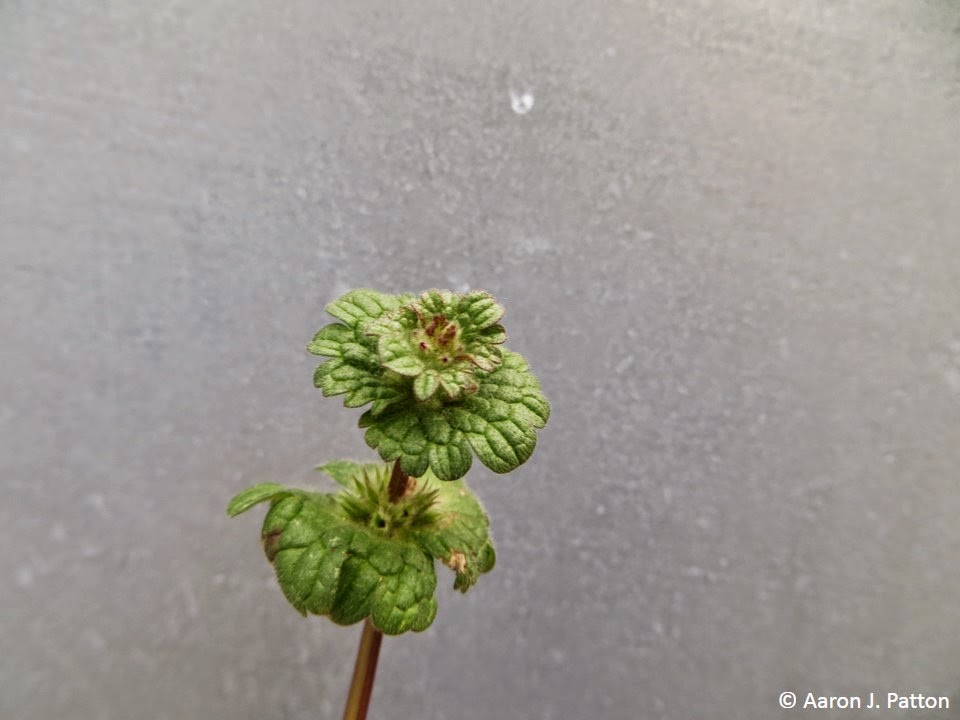Henbit
Biology: Henbit (Lamium amplexicaule) is a common winter annual broadleaf weed found throughout the United States. It can often be mistaken for another closely related winter annual broadleaf, purple deadnettle. Both can be observed by their showy pink to purple flowers which are primarily produced in April, but can appear from March to November in Indiana.
Identification: Henbit is a winter annual, meaning that it germinates in the fall, survives the winter as a vegetative plant which eventually flowers, develops seed, and dies as temperatures increase in late spring to early summer. As a member of the mint family, henbit has a characteristic four-sided (square) stem which can be sparsely hairy and greenish to purplish in color. All henbit leaves are hairy. Upper leaves are deeply lobed and encircle the main stem at the base (no leaf stem). In contrast, purple deadnettle leaves are more triangular, less deeply lobed, and are more reddish in color than henbit. Henbit flowers are small, pinkish-purple with darker coloring on the lower petal, arranged in whorls, and are tubular in shape.
 |
| Early growth stage. Leaves are lobed and round-shaped. |
 |
| Square-shaped stem |
 |
| Tubular-shaped flowers |
 |
| Two-lipped opening at the top of mature flowers |
 |
| Upper leaves have no leaf stems (petioles) |
 |
| Leaves toward the base of the plant have long stems (petioles) |
 |
| Prostrate growth habit in dormant turf |
 |
| Prostrate growth habit in a landscape |
 |
| Bermudagrass lawn heavily populated with henbit |
Cultural control: Cultural practices that promote a dense, vigorous turf are the best way to reduce the encroachment of annual broadleaf weeds. For example, proper mowing (increased mowing heights), proper fertilization to improve turf density, irrigation to prevent drought stress, and aerification of compacted soils to improve root health are all cultural practices that can be used to manage henbit in turf. However, in situations where you only have a few plants, you can usually just pull henbit by hand.
Biological control: There are some organic postemergence herbicides available to control henbit. For example, pelargonic acid (Scythe) and acetic acid (5% or greater solutions) may be used to manage weeds. Other products such as Eugenol, which contain medium-length fatty acids and clove oil, have shown also some promise as an effective weed control tool. However, these organic herbicides do not differentiate between the target weed and the desired turf (non-selective) and should only be applied as spot treatments in direct contact with the weed only. As a result, most of these organic herbicides have limited use in turf and are better suited for weed control in parking lots, along fence rows, and in other bare-ground areas.
Many new organic products contain iron HEDTA (FeHEDTA) as the active ingredient. Multiple applications of these products are required for adequate weed control and turf injury is generally decreased (can actually make the turf darker); however, their ability to control weeds is not well-documented.
Chemical control: Henbit can be controlled by using both preemergence and postemergence herbicides. However, preemergence control is mostly utilized in bermudagrass and zoysiagrass lawns so chemical control discussions will focus predominantly on postemergence herbicides. Most postemergence herbicides that contain 2,4-D, dicamba, floroxypyr, triclopyr, and others will control henbit. The ideal time to make herbicide applications is when the plant is small in autumn. As the plant gets bigger, herbicides will become less effective at controlling henbit. Additionally, winter annuals will naturally die in the summer; therefore, late spring herbicide applications are generally not needed. When henbit leaves start to turn yellow in color, they are beginning to die naturally from heat stress and herbicide applications are no longer necessary.
Aaron Patton, Turfgrass Extension Specialist
Leslie Beck, Postdoctoral Research Associate
